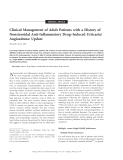
A history of drug
-
Philip Kindred Dick (December 16, 1928 – March 2, 1982) was an American science fiction novelist, short story writer, and essayist. Dick explored sociological, political and metaphysical themes in novels dominated by monopolistic corporations, authoritarian governments, and altered states. In his later works, Dick's thematic focus strongly reflected his personal interest in mysticism and theology. He often drew upon his own life experiences and addressed the nature of drug use, paranoia and schizophrenia, and mystical experiences in novels such as A Scanner Darkly and VALIS.
 26p
26p  hotmoingay7
hotmoingay7
 23-01-2013
23-01-2013
 58
58
 8
8
 Download
Download
-
At the end of the session, participants should be able to: understand the complexity of drugs and classification of the drugs, define the society and understand the relation between drugs and society, understand the various interventions that can be used to mediate the impact of drugs on society.
 43p
43p  tuoihaimuoi32
tuoihaimuoi32
 19-06-2014
19-06-2014
 76
76
 5
5
 Download
Download
-
Philip Kindred Dick (December 16, 1928 – March 2, 1982) was an American science fiction novelist, short story writer, and essayist. Dick explored sociological, political and metaphysical themes in novels dominated by monopolistic corporations, authoritarian governments, and altered states. In his later works, Dick's thematic focus strongly reflected his personal interest in mysticism and theology. He often drew upon his own life experiences and addressed the nature of drug use, paranoia and schizophrenia, and mystical experiences in novels such as A Scanner Darkly and VALIS.
 13p
13p  hotmoingay7
hotmoingay7
 23-01-2013
23-01-2013
 56
56
 4
4
 Download
Download
-
Philip Kindred Dick (December 16, 1928 – March 2, 1982) was an American science fiction novelist, short story writer, and essayist. Dick explored sociological, political and metaphysical themes in novels dominated by monopolistic corporations, authoritarian governments, and altered states. In his later works, Dick's thematic focus strongly reflected his personal interest in mysticism and theology. He often drew upon his own life experiences and addressed the nature of drug use, paranoia and schizophrenia, and mystical experiences in novels such as A Scanner Darkly and VALIS.
 15p
15p  hotmoingay7
hotmoingay7
 23-01-2013
23-01-2013
 132
132
 6
6
 Download
Download
-
Tuyển tập các báo cáo nghiên cứu về y học được đăng trên tạp chí y học General Psychiatry cung cấp cho các bạn kiến thức về ngành y đề tài: Clinical Management of Adult Patients with a History of Nonsteroidal Anti-Inflammatory Drug–Induced Urticaria/ Angioedema: Update....
 7p
7p  thulanh10
thulanh10
 09-10-2011
09-10-2011
 74
74
 3
3
 Download
Download
-
Đây là lần đầu tiên, FDA cho dùng thuốc trị ưu trầm thay đổi theo mùa, nhiều nhất về mùa Đông. Những công phạt của Wellbutrin XL như cơ thể kích thích, buồn bã, khó ngủ. Thử nghiệm cho thấy thuốc tương đối an toàn trị bệnh ưu trầm thay đổi theo mùa. (Xin đọc phần cuối: Ưu Trầm Trong Mùa Ðông, Trần Mạnh Ngô, M.D., Ph.D.) FDA Approves the First Drug for Seasonal Depression The Food and Drug Administration (FDA) today approved Wellbutrin XL for prevention of major depressive episodes in patients with a history of seasonal affective...
 7p
7p  nganluong111
nganluong111
 14-04-2011
14-04-2011
 67
67
 2
2
 Download
Download
CHỦ ĐỀ BẠN MUỐN TÌM


















